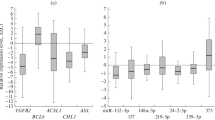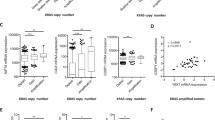Abstract
As a model system for the identification of genes involved in the progression of human breast cancer, differential gene expression in cell lines MCF-7 and MCF-7ADR was investigated. The latter cell line is derived from the former. Cell line MCF-7 is estrogen receptor-positive, vimentin-negative and uninvasive in the Matrigel outgrowth assay and in the nude mouse, while MCF-7ADR is estrogen receptor-negative, hormone-resistant, vimentin-positive, invasive in the Matrigel outgrowth assay and in the nude mouse and resistant to adriamycin due to overexpression of glycoprotein gp170. We have shown that tumor progression in this model system is mediated by transcriptional regulation of mitochondria-related genes, proteases, transmembrane receptors and cell cycle-related gene proteins. Among the genes differentially regulated at the transcriptional level in the cell lines MCF-7 and MCP-7ADR are a new mitochondrial transcript, mitochondrial creatine kinase, matrix metalloproteinase-1, stromelysin-3, urokinase and its receptor, tissue factor, E-cadherin, epidermal growth factor receptor, transmembrane proteins Mat-8 and progression associated protein (PAP), cyclin E, cyclin-dependent kinase-2 and cell cycle inhibitory proteins p16, p21 and p27.
Similar content being viewed by others
References
Kinzler KW and Vogelstein B, 1996, Lessons from hereditary colorectal cancer. Cell, 87, 159–70.
Clarke R, Brünner N, Thompson EW, et al. 1989, The inter-relationships between ovarian-independent growth, tumorigenicity, invasiveness and antiestrogen resistance in the malignant progression of human breast cancer. J Endocrinol, 122, 331–40.
Sommers CL, Heckford SE, Skerker JM, et al. 1992, Loss of epithelial markers and acquisition of vimentin expression in Adriamycin-and Vinblastme-resistant human breast cancer cell lines. Cancer Res, 52, 5190–7.
Sommers CL, Walker-Jones D, Heckford SE, et al.1989, Vimentin rather than keratin expression in some hormone-independent breast cancer cell lines and in oncogene-transformed mammary epithelial cells. Cancer Res, 49,4258–63.
Saceda M, Lippman ME, Chambon P, et al. 1988, Regulation of the estrogen receptor in MCF-7 cells by estradiol. Mol Endocrinol, 2, 1157–62.
Soule HD, Vazquez J, Long A, Albert S and Brennan M, 1973, A human cell line from a pleural effusion derived from a breast carcinoma. J Nat Cancer Inst, 51,1409–16.
Fan-child CR, Ivy SP, Kao-Shan CS, et al. 1987, Isolation of amplified and overexpressed DNA sequences from Adriamycin-resistant human breast cancer cells. Cancer Res, 47, 5141–8.
Thompson EW, Soonmyoung P, Brünner N, et al.1992, Association of increased basement membrane invasiveness with absence of estrogen receptor and expression of vimentin in human breast cancer cell lines. J Cell Physiol, 150, 534–44.
Liang P and Pardee AB, 1992, Differential display of eukaryotic messenger RNA by means of the polymerase chain reaction. Science, 257, 967–70.
Liang P, Averboukh L, Keyomarsi K, Sager R and Pardee AB, 1992, Differential display and cloning of messenger RNAs from human breast cancer versus mammary epithelial cells. Cancer Res, 52, 6966–8.
Liang P, Averboukh L and Pardee AB, 1993, Distribution and cloning of eukaryotic mRNAs by means of differential display: refinements and optimization. Nucleic Acids Res, 21, 3269–75.
Chomczynski P and Sacchi N, 1987, Single-step method of RNA isolation by acid guanidium thiocyanate-phenol-chloroform extraction. Analyt Biochem, 162,156–9.
Schaefer B, 1995, Revolutions in rapid amplification of cDNA ends: new strategies for polymerase chain reaction cloning of full-length cDNA ends. Analyt Biochem, 227, 255–73.
Haas RC, Korenfeld C, Zhang Z, Perryman B, Roman D and Strauss AW, 1989, Isolation and characterization of the gene and cDNA encoding human mitochondrial creatine kinase. J Biol Chem,264, 2890–7.
Scambia G, Natoli V, Benedetti Panici P, Sica G and Mancuso S, 1986, Estrogen responsive creatine kinase in human breast cancer cells. J Cancer Res Clin Oncol, 112,29–32.
Chang DD and Clayton DA, 1984, Precise identification of individual promoters for transcription of each strand of human mitochondrial DNA. Cell, 36, 635–43.
Anderson S,_ Bankier AT, Barrell BG, et al. 1981, Sequence and organization of the human mitochondrial genome. Nature, 290, 457–62.
Wolf C, Rouyer N, Lutz Y, et al. 1993, Stromelysin 3 belongs to a subgroup of proteinases expressed in breast carcinoma fibroblastic cells and possibly implicated in tumor progression. Proc Natl Acad Sci USA, 90,1843–7.
Duffy MJ, 1993, Urokinase-type plasminogen activator and malignancy. Fibrinolysis, 7 , 295–302.
Contrino J, Hair G, Kreutzer DL and Rickles FR, 1996, In situ detection of tissue factor in vascular endothelial cells: correlation with the malignant phenotype of human breast disease. Nat Med, 2, 209–15.
Birchmeier W and Behrens J, 1994, Cadherin expression in carcinomas: role in the formation of cell junctions and the prevention of invasiveness. Biochem Biophys Acta, 1198,11–26.
Blasi F, 1988, Surface receptors for urokinase plasminogen activator. Fibrinolysis,2,73–84.
Aaronson SA, 1991, Growth factors and cancer. Science, 254, 1146–53.
Schiemann S, Rückels M, Engelholm LH, Schwirzke M, Brünner N and Weidle UH, 1997, Differential gene expression in human mammary carcinoma cells: identification of a new member of a receptor family. Anticancer Res, 17, 13–20.
Marvin KW, Fujimoto W and Jetten AM, 1995, Identification and characterization of a novel squamous cell-associated gene related to PMP22. J Biol Chem, 270, 28910–16.
Taylor V, Welcher AA, Amgen EST Program and Suter U, 1995, Epithelial membrane protein-1, peripheral myelin protein 22 and lens membrane protein 20 define a novel gene family. J Biol Chem, 270, 28824–33.
Welcher AA, Suter U, De Leon M, Jackson Snipes G and Shoaiote EM, 1991, A myelin protein is encoded by the homologue of a growth arrest-specific gene. Proc Natl Acad Sci USA, 88, 7195–8.
Spreyer P, Kuhn G, Hanemann GO, et al. 1991, Axon-regulated expression of a Schwann cell transcript that is homologous to a 'growth arrest-specific' gene. EMBO J, 10,3661–8.
Morrison BW, Moorman JR, Kowdley GC, Kobayashi YM, Jones LR and Leder P, 1995, Mat-8, a novel phospholemman-like protein expressed in human breast tumors, induces a chloride conductance in Xenopusoocytes. J Biol Chem, 270, 2176–82.
Keyomarsi K, O'Leary N, Molnar G, Lees E, Fingert HJ and Pardee AB, 1994, Cyclin E, a potential prognostic marker of breast cancer. Cancer Res, 54, 380–5.
Hannon GJ and Beach D, 1994, p15INK is a potential effector of TGF-β induced cell cycle arrest. Nature, 371,257–61.
Kamb A, Gruis NA, Weaver-Feldhaus J, et al. 1994, A cell cycle regulator potentially involved in genesis of many tumor types. Science, 264, 436–40.
El-Deiry WS, Tokino T, Velculescu E, et al. 1993, WAFI, a potential mediator of p53 tumor suppression. Cell, 75, 817–25.
Toyoshima H and Hunter T, 1994, p27, a novel inhibitor of G1 cyclin-cdk protein kinase activity, is related to p21. Cell, 78, 67–74.
Matsuoka S, Edwards MC, Bai C, et al. 1995, p57KIP2, a structurally distinct member of the p21CIP1 Cdk inhibitory family, is a candidate tumor suppressor gene. Genes and Develop, 9 , 650–62.
Elledge SJ, Richman R, Hall FL, Williams RT, Lodgson N and Harper JW, 1992, CDK2 encodes a 33-kDa cyclinA-associated protein kinase and is expressed before CDC2 in the cell cycle. Proc Natl Acad Sci USA, 89, 2907–11.
Jinno S, Suto K, Nagata A, et al. 1994, Cdc25A is a novel phosphatase functioning early in the cell cycle. EMBO J, 13,1549–56.
Galaktionov K, Lee AK, Eckstein J, et al. 1995, Cdc25 phosphatases as potential human oncogenes. Science, 269,1575–7.
Galaktionov K and Beach D, 1991, Specific activation of cdc25 tyrosine phosphatases by B-type cyclins: evidence for multiple roles of mitotic cyclins. Cell, 67,1181–94.
Ogretmen B and Safa AR, 1996, Down-regulation of apoptosis-related bcl-2 but not bcl-xL or bax proteins in multidrug-resistant MCF-7/Adr human breast cancer cells. Int J Cancer, 67,608–14.
Yamamoto A, Horai S and Yuasa Y, 1989, Increased level of mitochondrial gene expression in polyps of familial polyposis coli patients. Biochem Biophys Res Commun, 159,1100–6.
Torroni A, Stepien G, Hodge JA and Wallace DC, 1990, Neoplastic transformation is associated with coordinate induction of nuclear and cytoplasmic oxidative phosphorylation genes. J Biol Chem, 265, 20589–93.
Wang FL, Wang Y, Wong WK, et al. 1996, Two differentially expressed genes in normal human prostate tissue and in carcinoma. Cancer Res, 56, 3634–7.
Munaut C, Noel A, Weidle UH, Krell HW and Foidart JM, 1995, Modulation of the expression of interstitial and type IV collagenases in coculture of HT1080 fibrosarcoma cells and fibroblasts. Inv Metastasis, 15, 169–78.
Bolon I, Brambilla E, Vandenbunder B, Robert C, Lantuejoul S and Brambilla C, 1996, Changes in the expression of matrix proteases and of the transcription factor c-Ets-1 during progression of precancerous bronchial lesions. Lab Invest, 75, 1–13.
Buisson AC, Gilles C, Polette M, Zahm JM, Birembaut P and Toumier JM, 1996, Wound repair-induced expression of stromelysins is associated with the acquisition of a mesenchymal phenotype in human respiratory epithelial cells. Lab Invest, 74, 658–69.
Bracke ME, Vyncke BM, Bruyneel EA, et al. 1993, Insulin-like growth factor I activates the invasion suppressor function of E-cadherin in MCF-7 human mammary carcinoma cells in vitro. Br J Cancer, 68,282–9.
Author information
Authors and Affiliations
Rights and permissions
About this article
Cite this article
Schiemann, S., Schwirzke, M., Brünner, N. et al. Molecular Analysis of Two Mammary Carcinoma Cell Lines at the Transcriptional Level as a Model System for Progression of Breast Cancer. Clin Exp Metastasis 16, 129–139 (1998). https://doi.org/10.1023/A:1021941203905
Issue Date:
DOI: https://doi.org/10.1023/A:1021941203905




